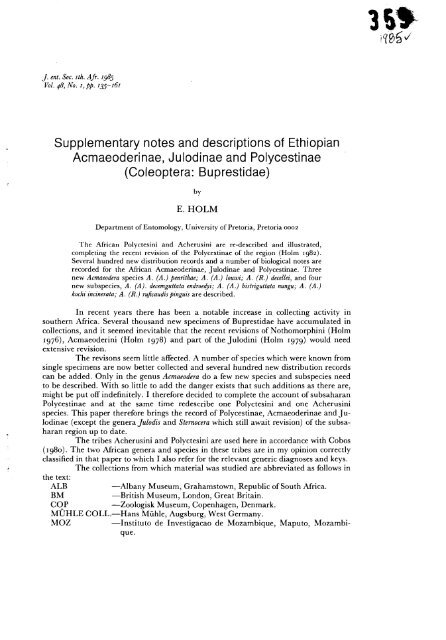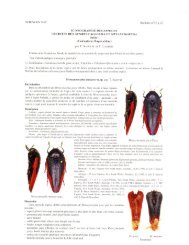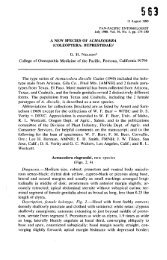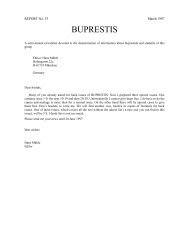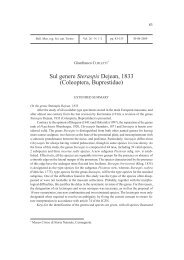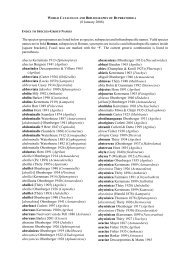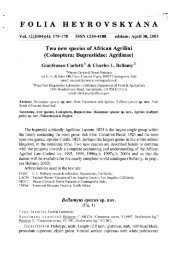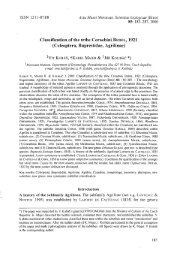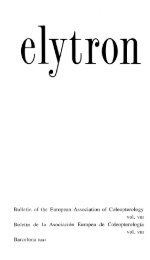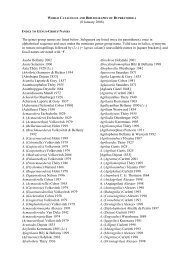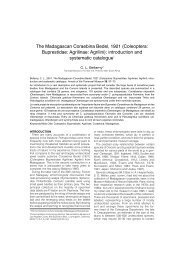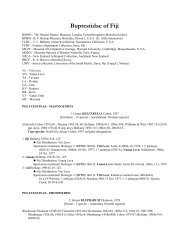Coleoptera: Buprestidae
Coleoptera: Buprestidae
Coleoptera: Buprestidae
Create successful ePaper yourself
Turn your PDF publications into a flip-book with our unique Google optimized e-Paper software.
J. ent. Soc. sth. Afr. 1985<br />
Vol. 48, No. I, pp. 135-161<br />
Supplementary notes and descriptions of Ethiopian<br />
Acmaeoderinae, Julodinae and Polycestinae<br />
(<strong>Coleoptera</strong>: <strong>Buprestidae</strong>)<br />
E. HOLM<br />
Department of Entomology, University of Pretoria, Pretoria 0002<br />
The African Polyctesini and Acherusini are re-described and illustrated,<br />
completing the recent revision of the Polycestinae of the region (Holm 1982).<br />
Several hundred new distribution records and a number of biological notes are<br />
recorded for the African Acmaeoderinae, Julodinae and Polycestinae. Three<br />
new Acmaeodera species A. (A.) penrithae; A. (A.) louwi; A. (R.) decellei, and four<br />
new subspecies, A. (A). decemguttata endroe+; A. (A.) bistriguttata nungu; A. (A.)<br />
kochi incine~ata; A. (R.) rujicaudis pinguis are described.<br />
In recent years there has been a notable increase in collecting activity in<br />
southern Africa. Several thousand new specimens of <strong>Buprestidae</strong> have accumulated in<br />
collections, and it seemed inevitable that the recent revisions of Nothomorphini (Holm<br />
1976), Acmaeoderini (Holm 1978) and part of the Julodini (Holm 1979) would need<br />
extensive revision.<br />
The revisons seem little affected. A number of species which were known from<br />
single specimens are now better collected and several hundred new distribution records<br />
can be added. Only in the genus Acmaeodera do a few new species and subspecies need<br />
to be described. With so little to add the danger exists that such additions as there are,<br />
might be put off indefinitely. I therefore decided to complete the account of subsaharan<br />
Polycestinae and at the same time redescribe one Polyctesini and one Acherusini<br />
species. This paper therefore brings the record of Polycestinae, Acmaeoderinae and Ju-<br />
lodinae (except the genera Julodis and Sternocera which still await revision) of the subsa-<br />
haran region up to date.<br />
The tribes Acherusini and Polyctesini are used here in accordance with Cobos<br />
(1980). The two African genera and species in these tribes are in my opinion correctly<br />
classified in that paper to which I also refer for the relevant generic diagnoses and keys.<br />
The collections from which material was studied are abbreviated as follows in<br />
the text:<br />
ALB -Albany Museum, Grahamstown, Republic of South Africa.<br />
BM -British Museum, London, Great Britain.<br />
COP -2oologisk Museum, Copenhagen, Denmark.<br />
MUHLE C0LL.-Hans Miihle, Augsburg, West Germany.<br />
MOZ -1nstituto de Investigacao de Mozambique, Maputo, Mozambi-<br />
que.
J. ent. Soc. sth. Afr. Vol. 48, No. 1,1985<br />
NCI -National Collection of Insects, Pretoria, Republic of South Afri-<br />
ca.<br />
PAR -Museum National d'Histoire Naturelle, Paris, France.<br />
PRA -NArodni Museum v. Praze, Prague, Czechoslovakia.<br />
RHO -National Museum, Bulawayo, Zimbabwe.<br />
SAM -South African Museum, Cape Town, Republic of South Africa.<br />
TER -Musee Royal de 1'Afrique Centrale, Tervuren, Belgium.<br />
TM -Transvaal Museum, Pretoria, Republic of South Africa.<br />
The <strong>Buprestidae</strong> material in the University of Pretoria collection was given to<br />
the Transvaal Museum in January 1985. The combined collection is housed on perma-<br />
nent loan at the University of Pretoria. All material and types listed under University<br />
of Pretoria (UP) in my previous papers (Holm 1976, 1978, 1979) are therefore now the<br />
property of the Transvaal Museum, c/o University of Pretoria.<br />
In this paper and henceforth, the combined collection will be referred to as<br />
the TM collection.<br />
Ambl_ysterna natalensis (Fahraeus)<br />
JULODINAE<br />
NEW RECORDS. ZIMBABWE: Chirundu, SE 16 28 Bb, 14.iii.1948 (TM).<br />
SOUTH AFRICA: NATAL: Ndumu game res., SE 26 32 Cd, iv.1970, C1. Besnard<br />
(TER); CAPE: Port Elizabeth, SE 33 25 DC, i.1970, C1. Besnard (TER). TRANS-<br />
VAAL: Stentor est., KAAPMUIDEN, SE 25 31 Cb, 5.iv.1983, S. L. Chown (TM);<br />
Chapudi, 5.iv.1932, G. V. Son (TM). MOZAMBIQUE: Estima, Sanangue, Cabora<br />
Bassa, SE 15 32 Db, xii.1973, Ferreira (MOZ).<br />
The record from Port Elizabeth is a considerable southern extension of the<br />
known distribution.<br />
Julodella cicatricosa (Germar)<br />
NEW RECORDS. CAPE: Rietfontein coast, SE 28 16 Dc, 6.x.1976, Endrody-<br />
Younga (TM); Koekenaap, SE 31 18 CA, 28.x. 1979, Endrody-Younga (TM).<br />
The Rietfontein specimen is an interesting nigrito-variation with bluish iridescence.<br />
Neojulodis (Protojulodis) laticollis (Gahan)<br />
NEW RECORDS. ETHIOPIA: Neghelli, 85 km E, NE 05 39 Dd, R. 0 . S. Clarke<br />
(TER); Sidamo prov., Dua Porma riv., 40 km SW (1050 m), NE 05 38 Bb, 12.v.1975,<br />
R. 0 . S. Clarke (TER). SOMALIA: 3 m. N Shahade, 22.v.1961, J. Roffey (BM); Afgoi,<br />
NE 02 45 Aa, 13.vii. 194.3 (BM).<br />
Neojulodis (Protojulodis) clermonti (Thkry)<br />
NEW RECORD. ZAIRE: Lubumbashi, SE I I 27 Ab, xi. 1975, R. Beun (TER).<br />
Neojulodis (Protojulodis) myrmido myrmido Fairmaire<br />
NEW RECORD.<br />
ETHIOPIA: Neghelli, go km E (goo-1200 m), Ne 05 39 Dd,<br />
I 7.v. 1975, R. 0 . S. Clarke (TER).<br />
This specimen is transitional to subspecies N. (P.) m. politicorum Holm.
Holm: Ethiopian Acmaeoderinae, Julodinae and Polycestinae I37<br />
Neojulodis (Protojulodis) myrmido politicorum Holm<br />
NEW RECORD. ETHIOPIA: Neghelli, I 05 km E ( I 300- 1500 m), NE 05 39 Dd,<br />
8.v.1974, R. 0 . S. Clarke (TER).<br />
Neojulodis (Protojulodis) myrmido semiimpressa Thkry<br />
NEW RECORD. UGANDA: Mt. Utut, Kadam, iv. 1955, V. Someren (BM).<br />
Neojulodis (Protojulodis) uittipennis uittipennis (Fahraeus)<br />
NEW RECORDS. ANGOLA: Mossamedes, SE I 2 I 5 Aa, 1910, Arnsorge (BM);<br />
Pediva, 30 m E of Porto Alexandre, SE I I 15 Dd, 28.vi. 1954 (400 ft on Mopane), Balfour-Browne<br />
(BM). NAMIBIA1S.W.A.: Oujuma 55 m NW Tsumeb, SE 19 17 Ba,<br />
1g.ii.1972 (BM). ZIMBABWE: Inyati Mine, SE 19 28 Db, i.1969, R. Nielson (BM).<br />
ZAMBIA: Livingstone, SE 17 25 Dd, 23.2.1913, H. C. Dollman (BM). SWAZILAND:<br />
Manzini, SE 26 31 Ad, xii.1970, T. Maguire (BM). SOUTH AFRICA: TRANS-<br />
VAAL: Mogol Nat. Res., SE 23 27 Dd, 26.i. 1982, R. G. Oberprieler (NCI); Langjan<br />
Nat. Res., SE 22 29 CC, 20.i.1980, P. Smith (NCI); Rustenburg Nat. Res. SE 25 27 Ac,<br />
I 2.ii. 1983 (NCI).<br />
Neujulodis (Protojulodis) uittipennis subuittata (Saunders)<br />
NEW RECORDS. ZIMBABWE: Christon Bank, SE 17 31 Dd, 15.xii.1g73, V.<br />
Allard (TER); Kariba, SE 16 28, 1965, H. Mathes (TER). MALAWI: Ft. Maguire-Ft.<br />
Johnston, SE 14 35 Aa, 17.iii. 1910, S. A. Neave (BM); Ruo Valley, SE 15 39 Dc,<br />
25.i~. 1910, S. A. Neave (BM); Ft. Mangoche-Chika la Boma, SE 14 35 Cd, 25.iii. 1910,<br />
S. A. Neave (BM). MOZAMBIQUE: Estima, Cabora Bassa, SE 15 32 Db, iv.1973,<br />
Ferreira (MOZ).<br />
Neojulodis (Protojulodis) uittipennis satanas Obenberger<br />
NEW RECORD. ZAMBIA: Mwengwa, S.E. 15 25 Bd, 13.ii.1914, H. C. Dollman<br />
(BM) -<br />
Neojulodis (Protojulodis) uittipennis sebastiani Holm<br />
NEW RECORD. SOUTH AFRICA: CAPE: Kenhardt (16 km N), SE 29 2 I Ac,<br />
1g.ii.1980, V. B. Whitehead (SAM).<br />
Neojulodis (Neojulodis) picta picta (Thunberg)<br />
NEW RECORDS. SOUTH AFRICA: CAPE: Clanwilliam (20 km N), SE 32 18<br />
Bd, g.ix.1982, V. B. Whitehead (SAM); Clanwilliam (21 km S), SE 32 18 Bd,<br />
3o.i~. 1981, V. B. Whitehead (SAM); Seweputs farm, SE 31 18 Cb, 25.v. 1981, Endrody-Younga<br />
(TM); Clanwilliam, 39 km NE, SE 31 19 Cb, 15.ix.1983, C. L. Bellamy<br />
(TM).<br />
Neojulodis (Neojulodis) picta uantonderae Holm<br />
NEW RECORD. SOUTH AFRICA: CAPE: Botterkloof pass, SE 31 19 Cd,<br />
15.i~. 1983, C. L. Bellamy (UP).<br />
Neojulodis (Neojulodis) tomentosa lasios Herbst<br />
NEW RECORD. SOUTH AFRICA: CAPE: Clanwilliam (21 km S), SE 32 18<br />
Bd, 30.ix.1981, V. B. Whitehead (SAM).
I 38<br />
J. ent. Soc. sth. Afr. Vol. 48, No. 1,1985<br />
Neojulodis (Neojulodis) tomentosa gnaphalon (Herbst)<br />
NEW RECORDS. SOUTH AFRICA: CAPE: Clanwilliam (39 k NE), SE 31 19<br />
Cb, 15.ix.1983, C. L. Bellamy (TM); Nuwerus, SE 3 I 18 Ad, 15.i~. 1983, C. L. Bellamy<br />
(TM); Eselsfontein, SE 30 I 8 Ac, 30.x. 1977, Endrody-Younga (grass netting) (TM);<br />
Vanryns Pass, SE 3 I I g Ac, 24.x. I 981, Endrody-Younga (on flowering fynbos) (TM);<br />
Tygerberg hills, SE 33 18 Dc, I 7.x. 1976 (TM); Niewoudtville, SE 31 19 Ac, 10.x. 1974<br />
(SAM).<br />
The specimen from Vanryns Pass is morphologically on the transition to subspecies<br />
N. (N.) t. lasios (Herbst).<br />
Neojulodis (Neojulodis) papillosa (Thunberg)<br />
NEW RECORD. SOUTH AFRICA; CAPE: Welbedacht grot, Cederberg, SE 32<br />
1 g Ac, I .xi. I 98 I, Endrody-Younga (on flowers) (TM).<br />
Thurntaxisia Schatzmayr<br />
POLYCESTINAE: POLYCESTINI<br />
Thurntaxisia Schatzmayr, 1 929: I 6<br />
Acassidiocesta Mandl, 1972: 27; Cobos 1980: 52 syn. nov.<br />
The genus Acassidiocesta was based on Polycesta cotpi Fairmaire by Mandl<br />
( 1 972). This genus is synonymous with Thurntaxisia Schatzmayr, 1929 (type species T.<br />
alexandri Schatzmayr). I have seen the type of P. cotpi and the description of T. alexan-<br />
dri, as well as correspondence (with drawing) between C. Koch and A. Thiry on the<br />
type of the latter. There is no doubt that the two type specimens are congeneric. This<br />
correspondence and synonymy was kindly brought to my attention by my colleague<br />
Prof. A. Descarpentries.<br />
Acassidiocesta schoemani Holm should therefore be Thurntaxisia schoemani (Holm)<br />
comb. nov.<br />
Thurntaxisia alexandri Schatzmayr<br />
Thurntaxisia alexandri Schatzmayr, I 929: 1 7<br />
Polycesta madoni ThCry, 1 93 I, 76 syn. nov.<br />
Acassidiocesta madoni Cobos I 980: 52<br />
The synonymy between these two species was pointed out to me in litt. by<br />
Prof. Descarpentries in Paris, and was verified by Mr. Miihle who compared the types.<br />
Polycestina (Damarana) damarana (Kerremans)<br />
NEW RECORD. NAMIBIA1S.W.A.: Brandberg, SE 2 I 14 Ab, xii.1981, E.<br />
Holm (TM).<br />
Pseudocastalia bennigseni bennigseni Kraatz<br />
NEW RECORD. MOZAMBIQUE: Cabora Bassa, SE 15 32 Cb, xi.1973, Ferrei-<br />
ra (MOZ).<br />
Psuedocastalia bennigseni dybowskyi Kerremans<br />
NEW RECORD. MOZAMBIQUE: Cadima, Cabora Bassa, SE 15 32 Da,<br />
xi. I 973, Ferreira (TM ex MOZ).
Holm: Ethiopian Acmaeoderinae, Julodinae and Polycestinae<br />
Pseudocastalia arabica arabica Gestro<br />
NEW RECORDS. SOMALIA: Laila, NE I I 42 Cb, 7.vi. 1895 (BM); Erigavo, NE<br />
ro 47 Ac, g.iv.1951, E. J. v. Ingen (BM).<br />
Pseudocastalia penrithae Holm<br />
NEW RECORD. SOUTH AFRICA: TRANSVAAL: Thabazimbi, SE 24 27 Cb,<br />
r 3.xi. I 983, E. Holm (on corrugated iron roof) (TM).<br />
This female specimen was dead when collected and rather damaged, but is<br />
most probably the female of P. penrithae or a subspecies thereof. It agrees with the male<br />
except in the following: larger (14 mm long); purplish-blue above, frontal sculpture<br />
finer; uneven numbered elytral costae not as carinate; elytral costae irregular in apical<br />
third.<br />
Castaliella laesicollis (Fairmaire)<br />
NEW RECORD. ZIMBABWE: Chipinda pools, SE gr 21 Cd, XII.rg82, C.<br />
Sharp (RHO).<br />
Cobosesta castelnaudi (Kerremans)<br />
NEW RECORD. SOUTH AFRICA: CAPE: Thursford Farm, SE 33 26 Ab,<br />
7.1.1983, H. G. Robertson (NCI).<br />
POLYCESTINAE: POLYCTESINI<br />
Polyctesis magnijca (Waterhouse) (Figs 25-29, 38, 47)<br />
Ptosima magnifica Waterhouse, I 875: 41 I; Kerremans I 884: 144, 1886: 164, I 903: 40, I 906:<br />
555; Obenberger 1926: 51; ThCry 1925: 225<br />
Schoutedenia kerremansi Obenberger, I 924: 15- I 7; ThCry 1925: 225<br />
Schoutedeniastes kerremansi Burgeon 194 1 : 185.<br />
Polyctesis magnifica Cobos I 980: 69.<br />
Length: 15,6 mm (male), 16,5- 18,3 mm (female); width 4,2 mm (male),<br />
4,8-5,2 mm (female).<br />
Yellow with black markings dorsally and ventrally, these black markings with<br />
a green metallic iridescence. Head with deep and dense umbilicate punctures except on<br />
a median smooth spot on frons, naked. Frons flat, epistome deeply and roundedly in-<br />
cised to level of antenna1 sockets. Eyes approximated dorsally, where distance between<br />
them is slightly more than length of eye. Pronoturn glabrous, sculpted like head but<br />
much finer on disc; mildly rounded in front and on sides, mildly bisinuate at base. Lat-<br />
eral ridge continuous, posterior quarter of length projecting and visible from above.<br />
Base as wide as elytral base and completely contiguous with it. Median basal fossa<br />
deep, extending forward as a short groove; lateral basal fossae deep and slightly larger.<br />
Elytra about gX as long as wide together, slightly depressed around the round scutel-<br />
lum, glabrous. Interstices flat except for two outer ones which are slightly constulate.<br />
All striae slightly constulate at apex; fourth, sixth and eighth terminating just before<br />
apical margin; striae fine, dense punctures sunk into shallow grooves; interstices with<br />
very fine single lines of punctures. Margin sharply but finely denticulate near apex,<br />
with apex of each elytron additionally strongly trispinose; hook above metacoxa very<br />
small or absent. Underside yellow with black markings along sutures and prelaterally on<br />
abdominal sternites. Sculpture small and rather sparse umbilicate punctures. Setation
J. ent. Soc. sth. Afr. Vol. 48, No. 1,1985<br />
very inconspicuous, fine, thin, sparse except on anterior rim of prosternum and poste-<br />
rior edge of abdominal sternites. Prosternum concave and with a rim in front, project-<br />
ing roundedly into sternal cavity behind. Mesepisternum rounded and smooth. Last<br />
abdominal sternite slightly concave preapically, the apex sharply ridged and evenly<br />
semicircular (female). Appendages with coxae and femora predominantly yellow; tibiae,<br />
tarsi and antennae black with green iridescence. All tarsal segments except last with<br />
well developed pads. Antenna 1 ,5X length of eye; second segment very short; fourth<br />
and onward dilated, each with a round patch of sensory pores on underside on these<br />
dilations; last segment bluntly rounded terminally. Hindwing, Fig. 26; aedeagus, Fig.<br />
29; length ovipositor, Fig. 27; length aedeagus, Fig. 28.<br />
The generic classification by Cobos (1980) is correct, making the generic<br />
names of Obenberger and Burgeon redundant. The distribution of the genus is interest-<br />
ing (Neotropical and southern Ethiopian), and would seem to indicate an early Gond-<br />
wana origin. The male, of which the first specimen has now been traced, differs from<br />
the female in having a marked protuberance on the distal end of the mesofemur, and<br />
the apex of the last sternite slightly concave. Twelve specimens have been collected.<br />
The species is so characteristic that the synonymy of S. kerremansi Obenberger<br />
(HT: TER) needs no discussion. The distribution is as indicated in Fig. 47, and deci-<br />
dedly does not extend to the "Cap b. Sp." as Obenberger's type is labelled. The bio-<br />
logy is unknown.<br />
MATERIAL EXAMINED. (12 specimens). ZIMBABWE: Turk Mine, SE 19 28<br />
Da, 16.xii.1957 (RHO; TM); Bulawayo, SE 20 28 Ba, Fred Eyles (TM); Limpopo, k<br />
SE 22 29, Saunders Collection (holotype of magnijica: BM), ditto (paratype of magnzjka:<br />
PAR). BOTSWANA: Francistown, SE 21 27 Da, Daniels (TM), CAPE (erratim):<br />
"Cap b. Sp.", Piringuey (holotype of kerremansi: TER).<br />
Polycestinae: Acherusini<br />
Bulis bivittata (F.) (Figs 8-1 2, 37, 47)<br />
~u~restis bivittata Fabricius, I 80 I : I 86; Schonherr I 8 I 7:2 I 2.<br />
Bulis bivittata Laporte & Gory I 837:2; Saunders I 87 1 :43; Kerremans I 892: I 00; I 903: I 50;<br />
Obenberger 1 g26:364; Cobos I 980: 77-78.<br />
Buprestis postulata; Thunberg, I 827:47.<br />
Figs 1-36. Morphology of Acmaeodera, Bulis and Polyctesis species from Africa and Madacascar.<br />
1-7, Acmaeodera (A.) penrithae sp. nov.: I. dorsal view; 2. aedeagus, dorsal and lateral<br />
view; 3. front tibia and tarsus; 4. frontal view; 5, lateral view without appendages; 6.<br />
length of ovipositor; 7. length of aedeagus. Figs 8-12, Bulis bivittata (F.): 8. dorsal<br />
view; 9. length of aedeagus; I o. length of ovipositor; I I. aedeagus, dorsal view; I 2.<br />
venation of hind wing. Figs 13-17, Acmaeodera (R.) decellei sp. nov.: 13. dorsal view; 14.<br />
front tibia and tarsus; 15. frontal view; 16. lateral view; 17. length of ovipositor. Figs<br />
I 8-24, Amaeodera (A.) nickerli Obenberger: I 8. dorsal view; I g. aedeagus, dorsal and<br />
lateral view; 20. front tibia and tarsus; 21. frontal view; 22. lateral view; 23. length of<br />
ovipositor; 24. length of aedeagus. Figs 25-29, Polyctesis magnijca (Waterhouse): 25.<br />
dorsal view; 26. venation of hind wing; 27. length of ovipositor; 28. length of aedeagus;<br />
29. aedeagus, dorsal view. Figs 30-36, Amaeodera (A.) louwi sp. nov.: 30. frontal view;<br />
31. lateral view; 32. dorsal view; 33. length of aedeagus; 34. length of ovipositor; 35.<br />
aedeagus, lateral and dorsal view; 36. front tibia and tarsus. All drawings to the pro-<br />
vided scale, except aedeagi and front legs (figs 2, 3, I I, 14, 19, 20, 29, 35 and 36)<br />
which are 2 x scale.
aouzlsa34od puu auuzpoln f 'auu~~apoauu~~v uutbo?~,llg :lulo~
J. ent. Soc. sth. Afr. Vol. 48, No. 1,1985<br />
Bulis postulata Saunders I 87 I :43; Kerremans I 903: I; Obenberger I g26:365; Cobos I 980: 7 8<br />
Bulis barians Laporte & Gory, I 835:2; Saunders 1871 :43; Kerremans 1903: I 50; Obenberger<br />
1926:365; Cobos 1980:78.<br />
Length: g, r-r2,6 mm (male), ro,5-r 5, r mm (female); width 2,g-4,0 mm<br />
(male), 3,2-4,8 mm (female).<br />
Brownish-black with yellow markings (Figs 8, 37). Head with densely placed<br />
deep punctures, slightly sparser and more irregular on lower part of frons where there<br />
are thin whitish setae. Frons attenuating dorsally, mildly depressed in the middle,<br />
wider than length of one eye above. Epistome nearly straight, below level of antenna1<br />
sockets. Pronotum sculptured like the head, attenuating anteriad, with setae on sides as<br />
on frons. Disc with two depressions in anterior third, sides constricted at this level. An-<br />
terior margin nearly straight, posterior margin strongly bisinuate and overlain by ely-<br />
tra. No basal fossae discernible. Side with a weakly developed ridge which ends in a tri-<br />
angular flat area on postero-distal corner of pronotum and fades out in the constriction<br />
of pronotum one third of length from front. Elytra about 2,5X as long as wide together,<br />
incompletely closed over scutellum which may show as a small remnant posteriad of<br />
elytral base. Setation very fine, short, white, inconspicuous. Sutural costae sharply<br />
ridged and slightly flaring out in posterior half of length. Scutellar and second costa<br />
reaching to within one quarter of elytral length from apex; third, fifth, seventh and<br />
ninth costae elevated, wider than even-numbered costae, third and fifth merging pre-<br />
apically. Striae round punctures, about half as wide as even-numbered costae. Base of<br />
elytra strongly rounded, depressed prebasally except at third costa. Lateral margin<br />
with a sharp and entire ridge, smooth except for a small denticule above metacoxa, and<br />
one prominent apical point before the weaker sutural point at apex. Underside brown to<br />
metallic black with variable small yellow spots on metacoxa, mesepisternum and below<br />
eyes. Sculpture evenly and densely spaced small punctures which bear very thin<br />
whitish setae. Prosternum with straight thinly rimmed anterior edge on same level as<br />
anterior edge of pronotum, followed posteriad by a rounded bulge and a rounded de-<br />
pression. Posterior process projecting into sternal cavity bluntly rounded. Apex of last<br />
abdominal sternite with a thin bladelike and unsculpted edge, evenly rounded in<br />
female, roundedly truncate in male. Appendages with colour as on underside, but sparser<br />
punctures on legs. All tarsi with first four tarsal pads well developed. Metatibia with a<br />
dense linear brush of setae on outside. Antenna long, reaching base of pronotum in<br />
male, shorter in female; second segment shortest; fourth and onward dilated with<br />
round sensory areas on underside; terminal segment bluntly rounded. Hindwing, Fig.<br />
12; aedeagus, Fig. I I; length of ovipositor, Fig. ro; length of aedeagus Figs. 9. ,<br />
From the two syntypes of B. biuittata F. in Copenhagen I have selected and<br />
marked the better labelled and preserved female as lectotype, the male as paralecto-<br />
type. The two syntypes of B. uarians Castelnau and Gory in Paris are, as Cobos (1980)<br />
indicated, no more than colour varieties of B. biuittata, without conspicuous yellow<br />
markings. I have again selected and labelled the better preserved female as lectotype,<br />
the male as paralectotype. A male specimen marked "Transvaal" (erratim!) in the<br />
Obenberger collection (PRA) and another specimen without locality were marked as<br />
types of a variety by Obenberger, but not described. There is no significant difference<br />
between these specimens and the typical B. biuittata. The species B. biuittata is obviously<br />
a Gondwana relict like Polyctesis magnijica, with congeners in the Neotropical region.<br />
There are several records of the species being bred from Podocarpus species ('yellow-<br />
wood') in the Eastern Cape.
&<br />
Holm: Ethiopian Acmaeoderinae, Julodinae and Polycestinae I 43<br />
MATERIAL EXAMINED. (43 specimens). SOUTH AFRICA: NATAL: Karkloof,<br />
SE 29 30 Ac, 24. ix. 194.2, Marley (TM); Umgeni Poort, SE 29 30 Da, 14.i.1936, R. F.<br />
Lawrence (TM); 'Ntsubane, SE 27 32 Ca, 28.ix.1958, J. H. Grobler (NCI). CAPE:<br />
Knysna, SE 34 23 Aa, 24.i.1958, A. D. v. Rensburg (NCI); Addo, SE 33 25 Bc,<br />
xi.1942, A. Barnard (NCI); Katberg SE 32 26 Bc, i.1904, Gane (ALB); Boston, SE 33<br />
18 Dc, z.xii.1903 (ALB); Van Stadens Pass, SE 33 25 CC, i.1924, Brauns (TM); Tiervlei,<br />
SE 33 18 Dc, xii.1948 (NCI); Tsitsikama, SE 33 32 Dc, 11.i.1942, P. McGaffin<br />
(NCI); Alexandria, SE 33 26 Cb, 17.xii.1958, J. H. Grobler (NCI); Cap Bon. sp. Biuittata<br />
F. (lectotype of bivittatu: COP); no labels (paralectotype of biuittata: COP); Cap<br />
bon. sp. (lectotype, paralectotype of uarians: PAR).<br />
ACMAEODERINAE: NOTHOMORPHINI<br />
Nothomorpha minima Kerremans<br />
NEW RECORDS. SOUTH AFRICA: CAPE: Kotzesrus, SE 30 17 Dd,<br />
23.viii. I 979, Endrody-Younga (ground trap, faeces bait) (TM). NAMIBIAIS. W.A.:<br />
Sargdeckel, Klinghardt mt., SE 27 15 Bc, 2.x.1982, M. L. Penrith & J. Irish (WIN).<br />
The Sargdeckel record is the northernmdst for this species.<br />
Nothomorpha maior Kerremans<br />
NEW RECORDS. SOUTH AFRICA: CAPE: Strandfontein, SE 31 18 Cc,<br />
g.xi. 1975, Univ. Pret. exp. (TM); Mossel Bay, SE 34 22 Aa, 4.xi. 1938, R. E. Turner<br />
(BM).<br />
The Mossel Bay record is the easternmost for this species.<br />
Nothomorpha pauperata Thomson<br />
NEW RECORDS. SOUTH AFRICA: CAPE: Quaggafontein, Namaqualand, SE<br />
30 17 Ba, zg.viii.1977, Endrody-Younga (ground trap, meat bait); Dernbergsdraai<br />
farm, SE 30 17 Dc, 24.viii.1979, Endrody-Younga (ground trap, fermenting banana<br />
bait) (TM) .<br />
Nothomorpha latifons Holm<br />
NEW RECORDS. SOUTH AFRICA: CAPE: "Cap b. sp." Drege (COP); Rietfontein<br />
gate, Richtersveld, SE 28 16 Dc, 2.ix.1976, Endrody-Younga (ground trap,<br />
meat bait) (TM). NAMIBIA1S.W.A.: Witpootjieberg, Namib SE 22 I 5 CC, 23.v. 1978,<br />
Endrody-Younga (sandblown hill) (TM) .<br />
Nothomorpha verrucosa Castelnau & Gory<br />
NEW RECORDS. SOUTH AFRICA: CAPE: Montagu, SE 33 20 Cc, 30.x.1980,<br />
E. Holm (TM); Theronsberg, SE 33 19 Bc, 23.xii.1977, E. Holm (TM); Barrydale, SE<br />
33 20 Dc, 30.x.1980, E. Holm (TM); Malmesbury, SE 33 18 Bc, 30.x.1g80, E. Holm<br />
(TM); Welbedachtgrot, Cederberg, SE 32 I g Ac, I .xi. I 98 I, Endrody-Younga (on flowers)<br />
(TM).<br />
Nothomorpha rugosa rugosa (Thunberg)<br />
NEW RECORDS. NAMIBIAIS. W.A.: Stamprietfontein, SE 24 I 8 Ad, xi. I 948,<br />
Koch & van Son (TM). SOUTH AFRICA: CAPE: Koekenaap, SE 31 18 Ca,<br />
3 1 .viii. I 978, Endrody-Younga (ground trap, faeces bait) (TM).
1 44 J. ent. Soc. sth. Afr. Vol. 48, No. 1,1985<br />
Nothomorpha rugosa carinifrons Holm<br />
NEW RECORDS. SOUTH AFRICA: CAPE: Barrydale, SE 33 20 Dc, 30.x.1980,<br />
E. Holm (TM); Top ofBaineskloof, SE 33 19 Ca, 23.xii.1977, E. Holm (TM); Fransch-<br />
hoek, SE 33 19 Ca, 30.x.1g80, E. Holm (TM); NW Grahamstown, SE 33 26 Aa,<br />
6.~.1981, E. Holm (TM); Swartberg pass, SE 33 22 Ac, 3.iii. 1981, Endrody-Younga<br />
( I 700 m) (TM) .<br />
ACMAEODERINAE: ACMAEODERINI<br />
Acmaeodera (Acmaeodera). luteopicta Fahraeus<br />
NEW RECORD. BOTSWANA: 30 km E of Palapye, SE 22 27 Cb, 7.i.1981,<br />
E. Holm (TM).<br />
Acmaeodera (A.) signata keniensis Thtry<br />
NEW RECORDS. SOUTH AFRICA: NATAL: Mack's Pass, Ingwavuma, SE 27<br />
31 Bb, 13.i.1980, R. Oberprieler (TM). MOZAMBIQUE: Tahohokwane, SE<br />
2g.xii. I 966, Ferreira (MOZ) .<br />
Amaeodera (A.) lugubrina Boheman<br />
NEW RECORDS. NAMIBIA1S.W.A.: Karibib, SE 21 15 Dd, ii.1978, C. Kok &<br />
S. J. v. Tonder (NCI); Otjivarongo, SE 20 16 Bc, ii.1978, C. Kok & S. J. v. Tonder<br />
(NCI); Okahandja, SE 21 16 Dd, ii.1978, C. Kok & S. J. v. Tonder (NCI); Otawi, SE<br />
19 17 Cb, ii.1978, C. Kok & S. J. v. Tonder (NCI); Outjo, SE 19 16 Da, 12.iii.1979, V.<br />
B. Whitehead (SAM); Gobabis, SE 21 19 Dd, 22.iv.1981, R. A. E. Whitehead (SAM);<br />
Garfeld, Otjivarongo, SE 20 16 Ac, 8.iii. 1979, V. B. Whitehead (SAM); Ondangua, 38<br />
km SE, SE I 7 I 5 Dd, 9.v. 1 97 1 (WIN); Ameib 60, SE 2 I I 5 Dc, 9- I I .v. I 978, S. Louw<br />
& M.-L. Penrith (WIN). BOTSWANA: Linyati swamp, SE 18 24 Aa, 12.iii.1976<br />
(RHO). SOUTH AFRICA: CAPE: 38 km S Twee Rivieren, SE 26 20 Da, 23.iii.1983,<br />
R. Oberprieler (NCI).<br />
Acmaeodera (A.) Virgo virgo Boheman<br />
NEW RECORDS. ZIMBABWE: Inyati Mine, SE 19 28 Db, i.1969, R. Nielson<br />
(BM); Sengwa, Gokwe, SE 18 28 Bb, 18.xii.1982, G. Bell (TM). S.W.A: Okatombaka<br />
farm, Hereroland, SE 2 I I 7 Bb, 26.vi. 1978, Endrody-Younga (in ground traps) (TM).<br />
SOUTH AFRICA: TRANSVAAL: Nylsvley, SE 24 28 Da, vii.1976, L. Hasenjager<br />
(bred from Burkea africana) (TM); Mogol res. Ellisras, SE 23 27 Dd, 2g.xi. 1979, S. J. V.<br />
Tonder (NCI); 20 km SE Loskopdam, SE 25 29 Bc, 13.ii.1981, C. G. Moolman & W.<br />
Harrop (NCI); Thabazimbi, SE 24 27 Cb, 13.xi. 1983 (on Grewia sp. flowers) E. Holm<br />
(TM). CAPE: Kimberley, SE 28 24 Da, xi. 1896 (TM). MALAWI: Ft. Lister Mt., I roo<br />
m, SE 15 35 Dc, 2-4.xii.1983, C. L. Bellamy, E. Holm, J. v.d. Berg (TM) MOZAM-<br />
BIQUE: Dzunhe, Cabora Bassa, SE 34 32 Da, i.1974 Ferreira (MOZ); Tahokwane (?),<br />
2g.xii. I 966, Ferreira (MOZ).<br />
The Mozambique records are the first from that country.<br />
Acmaeodera (A.) amoenula Fahraeus<br />
NEW RECORDS. SOUTH AFRICA: TRANSVAAL: 18 km S. Roetan, SE 24<br />
29 Ca, 2.ii.1981, R. G. Oberprieler (NCI). NAMIBIA1S.W.A: Ameib Farm, 19 m.<br />
NW Karibib, SE 21 15 Dc, a.ii.1972 (sweeping) (BM). MOZAMBIQUE: Cabora Bassa,<br />
SE I 5 32 Cb, xii. 1973, Ferreira (MOZ).
'<br />
Holm: Ethiopian Acmaeoderinae, Julodinae and Polycestinae I45<br />
Acmaeodera (A.) grata grata Fahraeus<br />
NEW RECORDS. BOTSWANA: Maun, Crocodile Camp, SE 19 23 Da,<br />
28.xii. 1980, P. Reavell (NCI). SOUTH AFRICA: TRANSVAAL: Kopermyn, I 4 km<br />
NE Chuniespoort, SE 24 29 Ab, a.xii.1g81, R. G. Oberprieler (NCI); 20 km E Loskop-<br />
dam, SE 25 29 Bc, 13.ii.1981, S. J. V. Tonder & C. Kok (NCI); Percy Fife Nat. Res.,<br />
SE 24 29 Aa, 12.iii.rg80, C. Kok (NCI); Ben Alberts Nat. Res., SE 24 27 Cb,<br />
28.xi.1980, C. Kok (NCI); Mogol Nat. Res., SE 23 27 Dd, 23.xi.1979, M. W. Mansell<br />
(NCI); Hans Merensky Nat. Res. SE 23 30 Da, go.xi.1981, R. G. Oberprieler (NCI);<br />
Pontdrift, Limpopo, SE 22 29 Aa, 26.xii. I 969, M. I. Russell (BM); Thabazimbi, SE 24<br />
27 Cb, 13.xi.1983, E. Holm (TM). MOZAMBIQUE: Songo, Cadima, Cabora Bassa<br />
SE 15 32 Da, xi.1973, Ferreira (MOZ).<br />
Acmaeodera (A.) louwi sp. nov. (Figs 30-36,3g, 47)<br />
Length 6,4-8,g mm; width 2, I -3,o mm.<br />
Head (Fig. 30) mildly rounded, slightly depressed in middle of frbns. Frons as<br />
wide as long, sides parallel, covered with umbilici of which about 12 fit across the mid-<br />
dle. Eyes moderately large, slightly bulging. Setae moderately long, white, rather erect,<br />
inclined downward. Epistome with roundedly concave lower margin and slightly up-<br />
turned rim. Supra-antenna1 tubercles small. Pronotum about 2 X wide as long; with disc<br />
rounded and with a very mild longitudinal depression along the middle. Median basal<br />
fossa smaller and in a shallower depression than lateral ones. Side with a short, con-<br />
tinuous, more or less straight rim which is not visible from above; widest one third of<br />
length from base, from there rounded to base and straighter to head. Anterior margin<br />
very feebly pointed in the middle, nearly straight, with a very vague submarginal<br />
groove. Sculpture consisting of punctures with rounded, shiny rims on disc, rims be-<br />
coming more or less continuous concentric lines around disc and a network between<br />
much larger punctures on sides. Setae as on head but slightly longer, curved forward.<br />
Elytra roundedly acuminate in apical third, apex shortly rounded. Apical denticulation<br />
moderately long, well developed. Base straight but slightly concave on either side, with<br />
an upturned collar followed by a depression which is deepest in scutellar area. Humeri<br />
prominent, evenly rounded, finely and sparsely punctured. Striae sloping punctures,<br />
about one quarter diameter of interstices, sunk into shallow rounded grooves in apical<br />
quarter of length only. Interstices equally elevated, flat, each with a single row of setae<br />
which are as on pronotum, but more erect, slightly inclined backward. Underside black<br />
with fairly dense white setae which are inclined backward. Sculpture umbilicate on<br />
sides, becoming horseshoe-shaped towards the middle. Prosternum with a groove and<br />
rim in front, the edge about straight and behind that of pronotum. Metacoxa with a<br />
straight rear margin, postero-distal corner rounded. Proepisternum with only about six<br />
scattered large umbilici, otherwise unsculptured. Appendages black, with setae as on<br />
head. All tibiae thin, with setal brushes on distal portion of inside and outside of meta-<br />
tibia. Setal burshes tinged with yellow. Antenna reaching to middle of pronotum, third<br />
segment thinnest, fourth moderately dilated, fifth to eleventh dilated and globose. Ae-<br />
deagus, Fig. 35; ovipositor length, Fig. 33; aedeagus length, Fig. 36.<br />
A. nickerli, (a species very similar to A. louwi) was described by Obenberger<br />
(1924) from a single specimen marked "Afrique mer.", and was identified by me<br />
(Holm 1978) as a wrongly labelled specimen from Madagascar. In the meantime the<br />
species here described as A. louwi has repeatedly been collected in Namibia/South West<br />
Africa. The species belongs to the affabilis-group of rather flat species with large prono-
I 46<br />
J. ent. Soc. sth. Afr. Vol. 48, No. 1, 1985
Holm: Ethiopian Acmaeoderinae, Julodinae and Polycestinae I47<br />
tal markings (in A. nickerli these latter vary from yellow to brick red while in A. louwi<br />
they are always yellow). In my key (Holm I 978) the species keys to 41, where it cannot<br />
be keyed further because of the combination of umbilicate frontal sculpture but no<br />
median spot on pronotum, thus distinguishing it from both the groups that follow on 41<br />
and on 46.<br />
A. louwi is morphologically very conservative and probably a relict in the Afri-<br />
can fauna. This is not only borne out by its morphology, but also its limited distribu-<br />
tion range and similarity to the Madagascan A. nickerli. One specimen was collected on<br />
Ficus sycomorus in the Namib Desert.<br />
MATERIAL EXAMINED. HOLOTYPE (male), ALLOTYPE: NAMIBIAIS. W.A.:<br />
Bethanis, SE 20 14 Ad, 12-14.v. 1978, S. Louw & M-L. Penrith (HT: WIN, AT: TM).<br />
8 PARATYPES: NAMIBIA1S.W.A.: Fish River Canyon, SE 27 17 Da, 23.ii.1963, F.<br />
Gaerdes (WIN): Kuiseb r. nr. Gobabeb, SE 23 15 Ca, 2o.iii.1983. Nat. Coll. Kuiseb<br />
survey (NCI); Ameib, SE 21 15 Dc, 9-1 1.v.1978, S. Louw & M-L. Penrith (WIN);<br />
Karibib, 7 km NE, SE 21 15 Dc, I 1.v.1978, S. Louw & M-L. Penrith (TM ex WIN);<br />
Duineveld, SE 20 14 Dc, 14-16.v.1978, M-L. Penrith & S. Louw (WIN).<br />
Acmaeodera (A.) nickerli Obenberger (Figs I 8-24, 40)<br />
Acmaeodera nickerli Obenberger, 1g24:g8; Holm 1g78:4g; 1g7g:25.<br />
Length 5,3-7,4 mm, width I ,8-2,3 mm.<br />
Head (Fig. 21) with frons deeply and roundedly depressed along middle, as<br />
wide as long between eyes, sides straight and slightly attenuating towards epistome.<br />
Epistome strongly projecting, angularly incised below. Supra-antenna1 tubercles small.<br />
Sculpture of large semi-umbilicate punctures, of which about 14 fit between eyes and<br />
which become sparser and larger towards middle. Setae white, very short, erect and<br />
slightly downwardly inclined. Pronotum with disc mildly rounded. Basal fossae small but<br />
very deep, lateral ones with slight surrounding depressions. Sculpture on disc as on<br />
head, but punctures becoming larger and deeper on sides, where they are semi-contigu-<br />
ous, leaving only a honeycomb-like maze of finely chiselled rims. Lateral margin with<br />
an entire, short, straight rim which is visible in last third from above. Anterior margin<br />
obtusely pointed in middle, base straight. Pronotum broadest in basal third of length,<br />
considerably wider than elytra at humeri. Setae over entire pronotum, very short,<br />
white, inconspicuous. Elytra about 3,5X as long as wide together, sides slightly widen-<br />
ing from behind humeri to middle of length, from there attenuating in a flat arch to<br />
shortly rounded apex. Apical denticulation fine but sharp. Base with a slightly up-<br />
turned rim. Humeral calli prominent, finely and sparsely punctured, rounded, shiny.<br />
Suture slightly depressed near base. Elytral striae narrow, elongate punctures, sunk<br />
into narrow shallow grooves everywhere but on basal third of disc, these grooves less<br />
than one quarter width of interstices. Interstices flat, slightly costulate at apex, with<br />
single rows of shallow punctures which become larger on sides and which bear very<br />
Figs 37-46. Colour variation in Polyctesis, Bulis and Acameodera species from Africa and Madagas-<br />
car. 37. Bulis biuittata (F.); 38. Polyctesis magnijca (Waterhouse); 39. Acmaeodera (A.)<br />
louwi sp. nov.; 40. A. (A.) nickerli Obenberger; 41. A. (A.) hessei Holm; 42. A. (A.) pen-<br />
rithae sp. nov.; 43. A. (A.) signifera Fahraeus; 44. A. (A.) gentilis Pkringuey; 45. A. (A.)<br />
decemguttata endroedyi subs p. nov. ; 46. A. (R.) ruficaudis pinguis subs p. nov.<br />
.-
1 48<br />
J. ent. Soc. sth. Afr. Vol. 48, No. 1,1985<br />
short white setae. Underside black, densely covered in small umbilicate punctures which<br />
become larger and deeper on thoracic sternites. Pro-episternum with only a few large<br />
and shallow umbilici. Interstitiary areas finely chiselled. Metacoxa with straight rear<br />
margin, obtusely rounded on postero-distal corner. Setation very short, white. Append-<br />
ages black with setae as on underside, but setal brushes on distal insides of tibiae and<br />
outside of metatibia longer and faintly yellow. All tibiae thin, protibia with a protrud-<br />
ing outer distal angle (Fig. 20). Antenna reaching beyond middle of pronotum, fourth<br />
segment hardly dilated, fifth segment not fully dilated. Aedeagus, Fig. 19; ovipositor<br />
length, Fig. 23; aedeagus length, Fig. 24.<br />
The species is known from five specimens (three male, two female) from two<br />
localities in southern Madagascar and an unknown locality. It has a very strong resem-<br />
blance to A. louwi (see above) but can be distinguished i.a. by the much finer sculpture<br />
and shorter setation all over. It is also more slender and has the frons much more deep-<br />
ly depressed. Nevertheless, the likeness is amazing considering the distribution of the<br />
two species. A. nickerli keys out to number 61 in my key to African Acmaeodera species<br />
(Holm 1978), where the distribution rules out further keying. The species can hardly<br />
be confused with any other Madagascan species, and only with A. louwi on the conti-<br />
nent.<br />
MATERIAL EXAMINED. (5 specimens). MADAGASCAR: Sikora, S. Madagascar<br />
(TM); Bekily, reg. Sud de 1711e, i.1933, A. Seyring (PAR); 'Afrique mer.' erratim!<br />
(holotype of nickerli; PRA) .<br />
Acmeodera (A.) kochi kochi Holm<br />
NEW RECORDS. NAMIBIA1S.W.A.: Grillental, 10 km S, SE 27 15 Ab,<br />
5.x.1982, M-L. Penrith, J. Irish & V. B Whitehead (WIN). SOUTH AFRICA: CAPE:<br />
Richtersveld, Rietfontein, SE 28 I 6 Cb, 2.viii. I 976, Endrody-Younga (TM); Oranjemund<br />
(10 km W Daberas), SE 28 16 Bb, g.ix. 1980, g.ix. 1980, V. B. Whitehead (SAM).<br />
Acmaeodera (A.) kochi incinerata subsp. nov. (Fig 48).<br />
This subspecies, which represents the parapatric inland form of the coastal A.<br />
kochi s. str., is significantly smaller (5,8-7,o mm long) than the latter. Apart from size,<br />
A. kochi incinerata differs from the nominal subspecies as follows: underside dark brown<br />
without maculae; dorsal yellow maculae darker and fading into black background<br />
around the edges; pronotal punctures and setae more densely placed; lateral carina of<br />
pronotum well developed along entire length; epistomal incision more angular. In other<br />
features, including male genitalia, the subspecies is very similar to the nominal form. It<br />
is distinguished from the similarly coloured A. decemguttata endroedyi as mentioned under<br />
the latter below, and also differs from A. hessei in lacking the concentric grooves around<br />
pronotal disc. The name is derived from the Latin for 'burned7, because of the dark<br />
orange dorsal maculae. At least three Acmaeodera s. str. species have forms in the hot in-<br />
Figs 47-48. 47. Distribution records of Polyctesis magnijica (Waterhouse); Bulis bivittata (F.); Ac-<br />
maeodera (A.) louwi sp. nov. and A. (A.) penrithae sp. nov. 48 Distribution of Acmaeodera<br />
(A.) kochi Holm, A. (A.) bistriguttata Spinola and A. (A.) decemguttata (Thunberg) with<br />
the new subspecies A. (A.) k. incinerata, A. (A.) b. nungu, A. (A.) d. endroedyi and A.<br />
(R.) rujicaudis pinguis.
auuzysagkjod puu auu~p01n~'auu~~apoauw~v uuzdozvg : wlo~<br />
6% I
I 50<br />
J. ent. Soc. 5th. Afr. Vol. 48, No. 1, 1985<br />
land of Namaqualand and Karoo show this colour change from black to orange (A. hes-<br />
sei, A. decemguttata and A. kochi).<br />
MATERIAL EXAMINED. HOLOTYPE (male), 2 PARATYPES: Kuboos, I o m<br />
W, Richtersveld [SE 28 16 Ac] 2 I .xi. 1949, C. Koch (TM); 5 PARATYPES: Brandkaross,<br />
L. Namaqualand [SE 28 16 Bc], v.1953, C. Koch (I BM; I PAR; 3 TM, all ex<br />
TM); PARATYPE: McMillans Pass, NE Rosh Pinah, S.W.A. [SE 27 17 Ca],<br />
I 6.x. I 972, A. Prinsloo (NCI).<br />
Acmaeodera (A.) hessei Holm (Fig 4 I)<br />
NEW RECORDS. SOUTH AFRICA: CAPE: Papendorp dunes, SE 31 18 Ca,<br />
2 I .viii. 1981, Endrody-Younga (TM); Elandsbaai, SE 32 I 8 Ad, 8.xi. 1978, V. B.<br />
Whitehead (SAM).<br />
A noteworthy new variation in colour pattern from Elandsbaai is illustrated<br />
in Fig. 41.<br />
Acmaeodera (A.) gentilis Pkringuey (Fig 44)<br />
NEW RECORDS. SOUTH AFRICA: CAPE: Steytlerville, SE 33 24 Ad,<br />
7.x.1981, E. Holm (TM); Grootklip farm, Namaqualand, SE 30 18 Db, 6.ix.1977,<br />
Endrody-Younga (ground trap, banana bait) (TM); Mata Mata, Kalahari Gemsbok<br />
Park, SE 25 20 Cc, x. I 957, C. Koch (TM) .<br />
The female specimen from Mata Mata represents a significant extension of<br />
the distribution range, and an unusual colour pattern (Fig 44). With more material it<br />
might prove to represent a distinct subspecies.<br />
Acmaeodera (A.) penrithae sp. nov. (Figs I-7,42, 47)<br />
Length 4,7-7,2 mm; width I ,4-2,5 mm.<br />
Head (Fig. 4) strongly rounded, roundedly depressed along middle of frons.<br />
Frons as wide as long with parallel sides, densely sculptured with deep punctures of<br />
which 20 fit across frons in middle. Setae long, white, rather erect, curved forward.<br />
Eyes normal, not bulging. Epistome very thin, lower rim broadly and roundedly con-<br />
cave, basal width one third of width between eyes. Supra-antenna1 tubercles very<br />
small. Pronotum rounded, slightly flattened on anterior half of disc. Median basal fossa<br />
very small, lateral ones larger but all three fossae deep, without surrounding depres-<br />
sions and near pronotal base. Sides evenly rounded, widest behind middle, side with a<br />
rim only on posterior half, rim very short and invisible from above. Anterior margin<br />
mildly bisinuate, not produced in middle. Base virtually straight. Sculpture and setae<br />
as on head, very regular all over, about 20 punctures fitting into length of disc. Yellow<br />
bands on sides only, often reduced to small spots in anterodistal corners. Elytra with<br />
sides concave behind humeri, widest behind middle and from there gradually rounded<br />
inward to bluntly rounded apex. Apex finely and shortly denticulate. Base mildly bisin-<br />
uate, rim hardly upturned. Humeral calli moderately prominent, smooth, reaching up<br />
to base. Striae round to slightly elongate punctures, closely set but not quite confluent,<br />
one-quarter or less width of interstices on disc but slightly larger on sides. Interstices<br />
flat to mildly rounded, none conspicuously elevated, with single rows of small punc-<br />
tures bearing short white setae (except second and third interstices which may have ir-
Holm: Ethiopian Acmaeoderinae, Julodinae and Polycestinae 151<br />
regular double rows in apical half of length). Underside black with a distinct blue and<br />
purple iridescence. Sculpture of small, densely spaced and deep punctures all over,<br />
these punctures only slightly sparser on pro-episternum and along the middle of body.<br />
Setae short, white, rather flat on body, dense. Anterior margin of prosternum on same<br />
level as pronotum in front, with a submarginal groove and short rim, straight. Meta-<br />
coxa with very mildly convex rear margin, distal corner bluntly angular. Appendages<br />
with colour and setae as on underside. Protibia thin but suddenly dilated distally with<br />
an angular distal corner (Fig 3). Brushes of setae on inside of protibia and outside of<br />
metatibia light, the latter much longer and sparser. Antenna very long, reaching well<br />
beyond pronotum, fourth segment slightly dilated but without sensory areas. Aedeagus,<br />
Fig 2; ovipositor length, Fig 6; aedeagus length Fig 7.<br />
The species keys to A. (A.) signifera in my key (Holm 1978) because of its dis-<br />
tribution. It is most easily separated from that species on strength of its much coarser<br />
pronotal sculpture and incomplete lateral pronotal ridge. The same characters distin-<br />
guish the species from other related species such as A. (A.) gentilis and A. (A.) kochi.<br />
From the former, it furthermore differs in lacking ridges around the pronotal disc, and<br />
from the latter in having a very thin epistome. A very characteristic feature of A. (A.)<br />
penrithae is the metallic coloration of the underside. There is a most striking resem-<br />
blance between A. (A.) penrithae and the subspecies A. (A.) pubemla guillarmodi from the<br />
eastern Cape. Apart from the great distance between the distribution ranges of the two<br />
forms, A. (A.) penrithae can be distinguished by lacking all maculae on the head and<br />
underside, and having the first and second elytral interstices uniserially punctate. The<br />
species is named in honour of Dr. Mary-Louise Penrith, one of the collectors of most of<br />
the type material.<br />
MATERIAL EXAMINED. Holotype 6, allotype: NAMIBIA1S.W.A.: Excelsior<br />
286, Windhoek, 22 27' S, I 7 38' E, 1-23 Aug. 1979, (preservative trap), S. Louw, M-L<br />
Penrith (WIN); Paratype: (same data) (TM); Paratype: Ondornsi falls, SE 17 13 Bd,<br />
Kaokoland 23-26 Aug. 1973 (WIN); Paratype: Ameib 60, Karibib, SE 2 I 15 Dc, 1-2<br />
Feb. I 972 (WIN); I 5 Paratypes: Voucher Collection, Richthofen/Excelsior, Windhoek<br />
district, Dec. 1977-Dec- 1979 (9 NCI, 3 TM, 1 BM, I PAR, I TER, I PRA, all ex<br />
NCI); Paratype: Richthofen I 26, Windhoek, 22 34' S, I 7 45' E, 1-3 I .viii. 1979, (preservative<br />
trap), S. Louw & M-L. Penrith (WIN); 16 Paratypes: Upper Ostrich Gorge,<br />
22' 19' S; 14' 59' E, Swakopmund dist., 8 May-5 June 1984, J. Irish & H. Liessner (10<br />
WIN, 6 TM); 10 Paratypes; Lower Ostrich Gorge, 22' 30' S; 14' 58' E, Swakopmund<br />
dist., 8 May-5 June 1984, J. Irish & H. Liessner (5 WIN, 5 TM);<br />
5 km N Arandis, 22' 22' S; 14' 59' E, Damaraland, 13 March-I April 1984, J. Irish &<br />
H. Liessner (WIN).<br />
Annaeodera (A.) decemguttata decemguttata (Thunberg)<br />
NEW RECORDS: SOUTH AFRICA: CAPE: Brandse baai, SE 31 17 Bd,<br />
29.x. 1 979, Endrody-Younga (TM); Grootdrif farm, SE 32 18 Ad, 2g.viii. I 98 I, Endrody-Younga<br />
(ground trap) (TM); Welbedacht grot, SE 32 19 Ac, 1.xi.1g81, Endrody-<br />
Younga (on flowers) (TM); Steytlerville, SE 33 24 Ad, 7.x.1981, E. Holm (TM); Phantom<br />
pass, SE 33 22 Dd, 10.x.1981, E. Holm (TM); Montagu, Se 33 20 Cc, 30.x.1980,<br />
E. Holm (UP); Ceres, SE 33 19 Ad, 30.x.1980, E. Holm (UP); Soutpan dunes, SE 31<br />
I 7 Bd, 29.x. 1979, Endrody-Younga (TM); Groot Toren, SE 3 I 19 Bc, I 3.i~. 1983, C. L.<br />
Bellamy (TM); Clanwilliam, 30 km NE, SE 3 I rg Cd, I 5.i~. 1983, C. L. Bellamy (TM).
I52<br />
J. ent. Soc. sth. Afr. Vol. 48, No. 1, 1985<br />
Acmaeodera (A.) decemguttata zonella Gory<br />
NEW RECORD. SOUTH AFRICA: CAPE: Boshof, Cederberg, SE 32 18 Bd,<br />
28.x. I 98 I, Endrody-Younga (on red sand) (TM) .<br />
Acmaeodera (A.) decemguttata goyi Saunders<br />
NEW RECORD. SOUTH AFRICA: CAPE: Stellenberg pass, SE 30 18 Ac,<br />
5.ix. I 97 7, Endrody-Younga (ground trap with millipedes) (TM) .<br />
Acmaeodera (A.) decemguttata endroedyi subsp. nov. (Figs 45, 48)<br />
The new subspecies has the same basal colour zoning as A. d. decemguttata, but<br />
the maculae are dark orange instead of yellow and fade into the black background<br />
around the edges, giving this subspecies a rather similar appearance to A. kochi<br />
incinerata described above. It can at once be distinguished from any form of A. kochi by<br />
the confluent puncture lines on the sides of the pronotal disc, the more flattened and<br />
pre-basally depressed pronotal disc, and the elevated ninth interstice.<br />
Apart from the different coloration, the new subspecies is distinguished from<br />
all other subspecies of A. decemguttata in having the concentric grooves on the pronotum<br />
the best developed and extending furthest onto the disc, and the setae on the underside<br />
and legs longest. The new subspecies is dedicated to my friend and colleague Sebastian<br />
Endrody-Younga, who collected the type series.<br />
MATERIAL EXAMINED. Holotype 8,<br />
veld, SE 28 16 Dc, 2.ix.1979, Endrody-Younga (singled on ground) (TM).<br />
2 Paratypes 9: Rietfontein coast, Richters-<br />
Acmaeodera (A.) caeruleonigra Obenberger<br />
NEW RECORDS. SOUTH AFRICA: CAPE: Welbedacht grot, SE 32 19 Ac,<br />
I .xi. 198 I, Endrody-Younga (TM); Jeep track, Cederberg, SE 32 19 Ac, 2.xi. 1981,<br />
Endrody-Younga (white flower bush) (TM); Wiedon, SE 31 18 Bc, 2o.ix.1982, M-L.<br />
Penrith (WIN).<br />
Acmaeodera (A.) capicola atratula Obenberger<br />
NEW RECORDS. SOUTH AFRICA: CAPE: Hondeklipbaai, SE 29 18 Cb,<br />
I 1.xi.1979, V. B. Whitehead (in yellow trap) (SAM); Knersvlakte, 20 km N Vanrhynsdorp,<br />
SE 31 18 Da, 6.x.1974, H. D. Brown (NCI); Mowers, Robertson, SE 33 19 Da,<br />
x.1952 (SAM); Kotzesrus, Namaqualand, SE 30 17 Dd, ng.viii.1979, Endrody-Younga<br />
(white dunes, day) (TM).<br />
The specimens from Mowers and Kotzesrus have the pronotal sides extremely<br />
bulging in the antero-distal corners. This feature is found to various degrees in different<br />
parts of the distribution (see Holm 1978: 29).<br />
Acmaeodera (A .) puberula puberula Solier<br />
NEW RECORDS. SOUTH AFRICA: CAPE: Verlorevlei farm, SE 32 18 Ad,<br />
27.x.1981, Endrody-Younga (yellow composites) (TM); Upper Olifants r., SE 23 31<br />
Dd, xii. I 949 (SAM).<br />
Acmaeodera (A.) puberula nautarum Obenberger<br />
NEW RECORDS. SOUTH AFRICA: CAPE: Franschhoek, SE 33 19 Cc,
Holm: Ethiopian Acmaeoderinae, Julodinae and Polycestinae I 53<br />
30.x. 1980, E. Holm (TM); Welbedacht grot, SE 32 19 Ac, I .xi. 1981, Endrody-Younga<br />
(TM)<br />
-<br />
Acmaeodera (A.) puberula guillarmodi Holm<br />
NEW RECORD. SOUTH AFRICA: CAPE: Hilton, Grahamstown,<br />
SE 33 26 Bc, 22-31.xii.1979, F. W. Gess (ALB).<br />
Acmaeodera (A.) gricilis (Wiedeman)<br />
NEW RECORDS. SOUTH AFRICA: NATAL: Estcourt, SE 29 29 Bb, xii. 1896,<br />
A. E. Haviland (TM). CAPE: Kogelberg, SE 34 18 Bd, 27.ii.1981, Endrody-Younga<br />
(flowering fynbos) (TM); Imvani, 26 km S Queenstown, SE 32 27 Aa, 29.xi.1982,<br />
V. B. Whitehead (SAM); Stutterheim, SE 32 27 Cb, 29.xi.1982, V. B. Whitehead<br />
(SAM); TRANSVAAL: Kransberg, SE 24 27 Bc, I 3.xi. 1983, E. Holm (TM).<br />
The record from Kransberg is most surprising. It means that the distribution<br />
of this member of the Cape montane community extends through the Drakensberg, and<br />
through the Waterberg right up to its western extreme.<br />
Acmaeodera (A.) conspersa conspersa (Thunberg)<br />
NEW RECORDS. SOUTH AFRICA: CAPE: Welbedacht grot, SE 32 19 Ac,<br />
I .xi. I 981, Endrody-Younga (TM); Jeep track, Cederberg, SE 32 I g Ac, 2.xi. I 98 I,<br />
Endrody-Younga (TM) .<br />
The hostplant of this species is the indigenous "rooibos"-tea, Aspalathus<br />
linearis, which is cultivated commercially in the western Cape.<br />
Acmaeodera (A.) bistriguttata bistriguttata Gory<br />
NEW RECORDS. SOUTH AFRICA: CAPE: Steytlerville, SE 33 24 Ad,<br />
7.x.1981, E. Holm (TM); Grootdrif farm, SE 32 18 Ad, ng.viii.1981, Endrody-Younga<br />
(TM); Tradouw pass, SE 33 20 Dc, 17.xi.1982, C. Eardley (NCI); Groot Toren,<br />
SE 31 19 Bc, I 3.ix. 1983, C. L. Bellamy (TM); Clanwilliam (30 km NE), SE 31 19 Cd,<br />
15.xi. 1983, C. L. Bellamy (TM); Anenous Pass, 12 km W. Steinkopf, SE 29 I 7 Bd,<br />
8.x.1972, A. Prinsloo (NCI).<br />
Acmaeodera (A.) bistriguttata nungu subsp. nov. (Fig 48)<br />
This single specimen seems to represent a subspecies of A. bistriguttata on the<br />
north-western limit of the distribution. The metacoxa has the typical setose cavity of<br />
the species; the maculation and broad head are also like in the typical form. The sub-<br />
species is distinguished, however, by having extremely long setae on the dorsal side,<br />
and an exceptionally short body. The setae on the elytra are longer than the width of<br />
two interstices together, while the setae on h e head and pr-onotum are only slightly<br />
longer than in the nominal form, though more erect. The maculae on the elytra are ex-<br />
ceptionally large and orange around the edges. (The type specimen has some damage<br />
to the appendages.)<br />
The name nungu is the name for the porcupine in several native languages and<br />
is chosen because of the porcupine-like appearance of the long setae.<br />
MATERIAL<br />
EXAMINED. HOLOTY PE: Springbok, I o m E, L. Namaqualand.<br />
[SE 29 1 7 Db], iii. I 958, G. van Son (TM).
J. ent. Soc. sth. Afr. Vol. 48, No. 1, 1985<br />
Acmaeodera (A.) signzfera signifera Fahraeus (Fig. 43)<br />
NEW RECORDS. SOUTH AFRICA: TRANSVAAL: Mogoto nat. res.,<br />
SE 24 29 Ac, 22.x. 1979, C. D. Eardley (NCI); Langjan nat. res., SE 22 29 CC,<br />
20.i. 1980, C. D. Eardley (NCI); CAPE: Kimberley (10 m N), SE 28 24 Db, 23.x. 1977,<br />
F. de Moor (TM); Kuruman (23 m SW), SE 27 23 Ca, 21.x.1972, A. L. V. Davis<br />
(TM).<br />
The specimens from Kimberley and Kuruman represent a southern extension<br />
of the known distribution. The former has exceptionally reduced yellow markings on<br />
the pronotal sides (Fig. 43, right).<br />
Acmaeodera (A.) signifera varicolor Boheman (Fig. 43)<br />
NEW RECORDS. Angola: Mocamedes, SE 15 12 Ab, xi. 1964, E. C. G. Pinhey<br />
(ex Welwitscha) (TM); NAMIBIAIS. W.A.: Swakopmund, SE 22 14 Ad, 26.i~. 1976,<br />
R. Oberprieler (NCI); Okakuju camp, Etosha, SE 19 15 Bb, 29.ii.1976, Dickson<br />
(TM); Kuiseb r. near Gobabeb, SE 23 15 Ca, 20.iii.1983, Nat. Coll. Kuiseb Survey<br />
(NCI); 15 km W Sesfontein, SE 19 I 3 Ab, I 7.i. 1981, Univ. Pretoria exp. (TM); Khowarib<br />
Schlucht, SE 19 13 Bd, 15.i.1980, Univ. Pretoria exp. (TM); 50 km W Mariental,<br />
SE 24 I 7 Da, 22.iii. 1983, I. M. Millar (NCI); Outjo Delhi, SE 20 15 Bc,<br />
14.iii.1g79, V. B. Whitehead (SAM). SOUTH AFRICA: CAPE: Vorstershoop,<br />
SE 25 23 Cc, 28.ii.1980, V. B. Whitehead (SAM); TRANSVAAL: Thabazimbi,<br />
SE 24 27 Cb, 13.xi.1983, (on Grewia-flowers), E. Holm (TM).<br />
The series from Angola has males with extremely reduced elytral pigmentation<br />
and maculae, forming the extreme of this coloration which tipifies the populations<br />
in the arid parts of the distribution (Fig. 43, left).<br />
Acmaeodera (A.) bzfasciata (Thunberg)<br />
NEW RECORDS. SOUTH AFRICA: CAPE: Welbedacht grot, SE 32 19 Ac,<br />
I .xi. 1981, Endrody-Younga (TM); Jeep track, goo m, SE 32 19 Ad, 2.xi. I 981, Endriidy-<br />
Younga (on ground and vegetation) (TM); Montagu, SE 33 20 Cc, 30.x.1980, E. Holm<br />
(TM).<br />
Acmaeodera (A.) alcmeone Thomson<br />
NEW RECORD. NAMIBIA1S.W.A.: Dreizackberg, 2 km N, SE 26 15 Cd,<br />
30.xi.1982, M-L. Penrith & J. Irish (WIN).<br />
Acmaeodera (A.) swammerdami swammerdami Obenberger<br />
NEW RECORDS. BOTSWANA: Serowe, SE 22 26 Bc, 18.xii.1982, Forchhammer<br />
(UP). SOUTH AFRICA: TRANSVAAL: Nylsvley, SE 24 28 Ad, 26.ix.1975,<br />
Endrody-Younga (ground trap) (TM). Mogol nat. res., SE 23 27 Dd, 23.xi.1979,<br />
v. Tonder, Kok, Prinsloo & Mansell (NCI).<br />
Acmaeodera (A,) tantilla Kerremans<br />
NEW RECORDS.<br />
NAMIBIA1S.W.A.: Kwandor, W. Caprivi, SE 17 23 Cb,<br />
16.xi.1979, Penrith, Coetzee & Scholtz (WIN). SOUTH AFRICA: TRANSVAAL:<br />
Pafuri, E-boundary, SE 22 31 Ac, 22.xi.1973, J. Braack (on Vitex amboniensis) (NCI);
Holm: Ethiopian Acmaeoderinae, Julodinae and Polycestinae I55<br />
Tzaneen, La Cotte, SE 23 30 Ca, g.x.1979, C. R. Owen (TM); Thabazimbi, SE 24 27<br />
Cb, 13.xi.1983 (on Grewia sp. flowers) E. Holm (TM); MALAWI: Kasunga, SE 13 33<br />
Aa, 8.xii. 1983, E. Holm (TM).<br />
Acmaeodera (A .) longicrinis 0 ben berger<br />
NEW RECORDS. SOUTH AFRICA: CAPE: Elandsbaai, SE 32 18 Ad,<br />
8.xi.1978, V. B. Whitehead (SAM); Groot Toren, SE 31 19 Bc, 1g.ix.1983, C. L. Bellamy<br />
(TM); Clanwilliam (30 km NE), SE 3 I 19 Cd, I 5.i~. 1983, C. L. Bellamy (TM).<br />
Acmaeodera (Rugacmaeodera) exasperans octoplagiata Kerremans<br />
NEW RECORD. MOZAMBIQUE: Cabora Bassa, SE 15 32 Cb, xi.1973, Ferreira<br />
(TM ex MOZ.).<br />
This record represents a considerable southern extension of the distribution.<br />
The specimen agrees very well with the type.<br />
Acmaeodera (R.) inscripta inscripta Fahraeus<br />
NEW RECORDS. SOUTH AFRICA: TRANSVAAL: Nyanlada, Pafuri SE 22<br />
31 Ac, 30.xi.1973, J. Braack (NCI); Shashanga fire break, 25.xi.1970, Braack (TM);<br />
Thabazimbi, SE 24 27 Cb, 1g.xi.1983, E. Holm (on Grewia sp. flowers) TM).<br />
Acmaeodera (R.) inscripta prinslooae Holm<br />
NEW RECORDS. NAMIBIA1S.W.A.: Erongo, 380 m, SE 21 15 Dc, 23.ii.1975,<br />
Endrody-Younga (grass netting) (TM); Windhoek, SE 22 17 Ca, 17.xii. 1983, R. Oberprieler<br />
(NCI). SOUTH AFRICA: TRANSVAAL: Baviaanskloof, SE 25 28 Cb (UP).<br />
Acmaeodera (R.) subprasina subprasina Marseul<br />
NEW RECORDS. ZIMBABWE: Christon Bank, SE 31 17 Dd, 1g.xii.1971, A. J.<br />
Duke (TM). SOUTH AFRICA: TRANSVAAL: Barberton, SE 25 31 Ca, 2g.iii.1979,<br />
C. G. Moolman (NCI); Ohrigstad, 12 km N, SE 24 30 Da, 18.xi.1983, B. Dombrowsky<br />
(TM)<br />
- The last mentioned series consists of dark specimens, transitional to subsp.<br />
thi~i Cobos.<br />
Acmaeodera (R.) rujcaudis rujcaudis de Geer<br />
NEW RECORDS.<br />
NAMIBIA1S.W.A.: ERONGO, 380 m, SE 21 15 Dc,<br />
23.ii.1975, Endrody-Younga (grass netting) (TM). BOTSWANA: Botletle, SE 20 24<br />
Cd, 12.xii.1975, P. Raevell (TM); Francistown, IIO km S, SE 22 27 Ab, 12.i.1978,<br />
Holm, Jacobs, Kirsten & Scholtz (TM). SOUTH AFRICA: TRANSVAAL: Nylsvley,<br />
SE 24 28 Da, vii.1976, L. Hasenjager (bred from Burkea africana) (TM); Mogoto nat.<br />
res., SE 24 29 Ac, 25.x.1979, G. L. Prinsloo (NCI); Nyala nat. res., SE 28 31 Ca,<br />
16.xii.1980, R. G. Oberprieler (TM); Kransberg, SE 24 27 Bc (2000 m), 13.xi.1983,<br />
E. Holm (TM); CAPE: Glen Lynden, SE 32 25 Db, Miss Leppan (TM); Quinera r.<br />
East London, SE 33 27 Bd, xi.1906, A. J. Duke. MALAWI: Dedza, 20 km NW, SE 14<br />
34 Ad, 9- 1 g.xii. I 983. C. L. Bellamy & E. Holm (TM).
156<br />
J. ent. Soc. sth. Afr. Vol. 48, No. 1, 1985<br />
Acmaeodera (R.) rujcaudis simillima Obenberger<br />
NEW RECORD. SOUTH AFRICA: TRANSVAAL: Lydenburg, 20 km N, SE<br />
25 30 Ba, 18.xi. 1983, B. Dombrowsky (TM).<br />
Acmaeodera (R.) rujcaudis pinguis subsp. nov. (Figs 46, 48)<br />
This subspecies is distinguished from others subspecies of A. (R.) rujcaudis in<br />
having a combination of the following features: Maculae on elytra zoned, and with<br />
characteristic maculae in the scutellar area (fig 46); fifth and ninth interstices strongly<br />
elevated in apical third as in A. (R.) rujcaudis comtulata; elytra short, head broad. This<br />
distinct subspecies occurs parapatrically to rujcaudis costulata on the one hand and<br />
ruJcaudis rufiaudis on the other. It seems to be a localized coastal form, and is named<br />
after its characteristic stout outline. It bears a strong resemblance to A. (R.) congener<br />
Spinola, but can be distinguished by its fifth and ninth interstice which are much more<br />
costulate, and its pronotal disc which is extremely rugose.<br />
MATERIAL EXAMINED. HOLOTYPE (male): Naxido na la quinzena de Maio<br />
[?Se I 7 36 Aa] I-3o.v. 1969, apanhados os paus em xi. 1969 posturas de vi. 1969 (TM ex<br />
Ferreira coll.); PARATYPE: Beira [SE 18 33 Ad], 8.i. 1904, P. A. Sheppard (BM ex<br />
O'Neill coll.); PARATYPE: Pamene, SE 22 35 Db, 18.xii. 1973, A. Strydom (TM).<br />
Acmaeodera (R.) congener Spinola<br />
NEW RECORDS. SOUTH AFRICA: CAPE: Queenstown, SE 31 26 Dd,<br />
2g.xi.1982, V. B. Whitehead (SAM); Clanwilliam, SE 32 18 Bb, 21.xii.1976, J. G.<br />
Theron (TM).<br />
Acmaeodera (R.) hieroglyphica hieroglyphica Fahraeus<br />
NEW RECORDS. SOUTH AFRICA: TRANSVAAL: Pafuri, E-boundary, SE 22<br />
31 Ac, 22.xi.1973, J. Braack (on Grewia) (NCI). MOZAMBIQUE: Cabora Bassa, SE<br />
I 5 32 Cb, 14.xi. 1973, Ferreira (MOZ).<br />
Acmaeodera (R.) uicina vicina Castelnau & Gory<br />
NEW RECORD. CAMEROUN: Fotokol, 36 km E, NE 12 14 Ca, 6.iii.1973,<br />
H.J. Magu (coll. HUHLE).<br />
Acmaeodera (R.) vicina pusilla Kerremans<br />
NEW RECORDS. SOUTH AFRICA: TRANSVAAL: Shingwedzi, SE 23 31 Ab,<br />
21.x.1973, H. Braack (NCI); Ben Alberts nat. res., SE 24 27 Cb, 28.xi.1980,<br />
C. Kok (NCI); Le Cotte, Tzaneen, SE 23 39 CC, g.x.1979, C. R. Owen (TM). MO-<br />
ZAMBIQUE: Cabora Bassa, SE I 5 32 Cb, (MOZ).<br />
Acmaeodera (R.) prorugosa Holm<br />
NEW RECORD.<br />
ETHIOPIA: Sidamo, 40 km SW of Dua Parma riv. 1050 m,<br />
NE 05 38 Bb, I 2.v. 1975, R. 0 . S. Clarke (TER).
Holm: Ethiopian Acmaeoderinae, Julodinae and Polycestinae<br />
Acmaeodera (Rugacmaeodera) decellei sp. nov. (Figs I 3- I 7)<br />
Length 8,1 mm; width 2,7 mm.<br />
Head (Fig. 15) virtually flat, slightly depressed along middle of frons. Frons<br />
wider than long, sides very slightly diverging dorsally, sculpture of hexagonal umbilici<br />
leaving a network of rounded common ridges between them, twelve umbilici fitting<br />
across width of frons. Eyes normal, not bulging. Setae white, short and very broadly<br />
squamose, one in each umbilicus. Epistome mildly and roundedly concave below, flat<br />
with a slightly upturned lower rim, with base just wider than one third of distance be-<br />
tween eyes and deeply grooved. Pronotum with four rounded depressions in a "+" ar-<br />
rangement on disc. Median fossa inconspicuous at base of a "u" shaped groove, lateral<br />
basal fossae very small at bases of unsculptured elongate depressions which open for-<br />
ward at about one-third of distance across pronotum. Sides with a straight flat rim<br />
along whole pronotal length. Anterior margin moderately and roundedly produced in<br />
the middle, base straight in middle half, rounded forward the outer corners. Widest in<br />
the middle, roundedly attenuated to base and front. Sculpture of deep large craters<br />
with common rounded rims on sides, becoming smaller, more spaced out and deeper<br />
on disc; apart from this sculpture, whole surface finely chiselled, matt. Setation as on<br />
head, directed forward and outward. Elytra with sides parallel to just behind middle of<br />
length, from there straightly attenuating to a pointed apex. Apical serration widely<br />
spaced along posterior third of elytral side, coarse but not very long on apical edge. In-<br />
terstices mildly rounded, eighth and ninth denticulate in apical third, with single rows<br />
of punctures which are very small on disc but become large, coarse and irregular near<br />
base and sides. Punctures each bear a squama as on head. Striae very narrow, with<br />
elongate punctures in a groove on disc but large round punctures obliterating inter-<br />
stices near base. Base with an upturned rim. Humerus unsculptured on top. Elytra<br />
long, more than 2X as long as wide together. Underside with sculpture and squamae (as<br />
on frons) along sides, except on a proepisternum which is naked and only finely chis-<br />
elled; punctures becoming very fine and sparse along middle of abdominal sternites.<br />
Prosternum with a groove and rim in front, this rim longer in the middle but without a<br />
well defined antenna1 incision. Metacoxa mildly concave in rear, with a prominently<br />
pointed distal corner. Appendages black, with thinly squamose white setae. Protibia di-<br />
lated with an angular distal corner (Fig. 14), other tibiae thin. Hairbrushes on inside of<br />
protibia and outside of metatibia light, the latter sparse and widely spaced. Antenna as<br />
long as width of frons, segments five to ten dilated, eleven globular. Ovipositor length,<br />
Fig. 17.<br />
The species is known from only one female specimen, but is so unique that<br />
there cannot be any doubt about its specific distinctness. The nearest relative is<br />
A. (R.) bequaerti Kerremans, with which it shares sculptural details, but from which it<br />
differs in coloration, much more squamose setation, elongation of elytral apex, and<br />
coarser sculpture on base of elytra. A. decellei keys out to A. bequaerti in my key (Holm<br />
1978), where it can readily be separated from the latter by the colour and more squa-<br />
mose setation.<br />
The species is named in honour of J. Decelle, renowned coleopterist of the<br />
Tervuren Museum, who collected the single specimen.<br />
MATERIAL EXAMINED. HOLOTYPE (female): Cote d'Ivoire; Zepreghe; Dalao;<br />
[:NW 06 06 Ab] J. Decelle. iii. 1962 (TER).
I 58<br />
Amaeodera (R.) stellata stellata Marseul<br />
J. ent. Soc. sth. Afr. Vol. 48, No. 1,1985<br />
NEW RECORDS. SOUTH AFRICA: TRANSVAAL: Nylsvley, SE 24 28 Da,<br />
1975, L. Hasenjager (bred from Terminalia sericea) (TM); Pafuri, E-boundary, SE 22 31<br />
Ac, 22.xi.1973, J. Braack (on Grewia) (NCI). NAMIBIA1S.W.A.: Swartbooisdrif, SE<br />
I 7 13 Bd, 10. I I. 1975, Endrody-Younga (on shore) (TM).<br />
Amaeodera (Paramaeodera) glabra Obenberger<br />
NEW RECORD. NAMIBIA1S.W.A.: Abachaus, SE 20 16 Bc, iii.1950, G.<br />
Hobohm (TM).<br />
Amaeodera (P.) albovillosa Fahraeus<br />
NEW RECORDS. SOUTH ARICA: TRANSVAAL: Langjan nat. res., SE 22 29<br />
Cc, 20.i. 1980, P. Smith (NCI). NAMIBIA1S.W.A.: Tondoro, Okovango, SE 17 18 Dd,<br />
14.i.1975, H. Roer (TM). MOZAMBIQUE: Mucangazi r., SE 15 31 Ca, i-iii.1973,<br />
Ferreira (MOZ).<br />
Acmaeodera (P.) eleuata Klug<br />
NEW RECORD. ETHIOPIA: Sidamo, I 05 km E of Neghelli, I 300- I 500 m, NE<br />
05 38 Bb, 7-8.v.1974, R. 0 . S. Clarke (TER).<br />
Amaeodera (P.) uiridaenea uiridaenea de Geer<br />
NEW RECORDS. SOUTH AFRICA: CAPE: Cradock, SE 32 25 Ba, Gericke<br />
(COP); Kei Bridge, SE 32 27 Db, i.1970, C1. Besnard (TER); Schoemanshoek, SE 33<br />
22 Ad, 19.i. 1973, V. B. Whitehead (SAM).<br />
Amaeodera (P.) uiridaenea swierstae Obenberger<br />
NEW RECORDS. SOUTH AFRICA: TRANSVAAL: Pietersburg, SE 23 29 Cd,<br />
17.xi.1976, P. E. Reavell (TM); Welgedacht, 50 km N Pretoria, SE 25 28 Bd,<br />
26.xi. 1977, J. Boomker (TM).<br />
Acmaeodera (P.) uiridaenea degeeri W a terhouse<br />
NEW RECORD. SOUTH AFRICA: TRANSVAAL: Stentor est., Kaapmuiden,<br />
SE 25 3 1 Cb, 5.iv. 1983, A. Nel (TM).<br />
Acmaeodera (P.) uiridaenea aureolimbata Boheman<br />
NEW RECORDS. NAMIBIA1S.W.A.: Okovongomingo, SE 20 I 7 Ca, 6.iii.1979,<br />
V. B. Whitehead (SAM); Mariental, 50 km W, SE 24 17 Da, 22.iii.1983, R. G. Ober-<br />
prieler (NCI). SOUTH AFRICA: CAPE: Frylinckspan, SE 27 22 Ba, SE 27 22 Ba,<br />
5.i.1980, Univ. Pret. exp. (TM); Vryburg, 4 km S, SE 26 24 Dc, 4.i.1980, Univ. Pret.<br />
exp. (TM); Bortdeaux, SE 24 24 Cb, 3.ii.1980, V. B. Whitehead (SAM).<br />
Acmaeodera (P.) fascigera Harold<br />
NEW RECORDS.<br />
BOTSWANA: Moremi, SE 19 23 Bc, g.i.1981, Univ. Pret.<br />
exp. (TM); Crocodile camp, Maun, SE 19 23 Dc, P. Reavell (NCI). MOZAMBIQUE:
Holm: Ethiopian Acmaeoderinae, Julodinae and Polycestinae I59<br />
Cabora Bassa, Mucangadzi r., SE 15 31 Ca, i.1973, M. C. Ferreira (TM). SOUTH<br />
AFRICA: TRANSVAAL: De Hoek Forest, SE 23 30 Cc, 17.xi.1979, N. J. V. Rensburg<br />
(NCI).<br />
Acmaeodera (P.) luculenta Boheman<br />
NEW RECORD. BOTSWANA: Moremi, SE 19 23 Bc, 9.i. 1981, Univ. Pret. exp.<br />
(TM). SOUTH AFRICA: TRANSVAAL: Trichardsdal, SE 24 30 Ab, 9.i.1982, R.<br />
Oberprieler (light trap) (NCI); Strydom-Motel, SE 24 30 Bc, 17.iv. 1973,<br />
A. Prinsloo & T. Bouwer (NCI). MALAWI: Dedza, 20 km N, SE 14 34 Ad,<br />
28-2g.xi.1983, (1250 m), C. L. Bellamy & J. v.d. Berg (TM). MOZAMBIQUE: Ca-<br />
bora Bassa, Se 15 32 Cb, xii.1973, Ferreira (MOZ); Songo, Cadima, Cabora Bassa, SE<br />
15 32 Da, xi. 1973, Ferreira (MOZ).<br />
Acmaeodera (P.) punctatissima Thomson<br />
NEW RECORDS. ZAIRE: P.N.C. I/~/I(?), 27.ii.1950, H. de Saeger, 220 (UP).<br />
SOUTH AFRICA: TRANSVAAL: Pretoria, SE 25 28 Ca, 15.xii. 1975, S. A. Steynberg<br />
(ex lemon tree) (TM); NATAL: Ladysmith, SE 28 29 Db (TM); Ndumu res., SE 26 32<br />
Cd, I 5.i. I 980, R. Oberprieler (TM).<br />
Acmaeodera (P.) smaragdina saundersi Waterhouse<br />
NEW RECORDS. ZIMBABWE: Kariba, SE 16 28, N. J. Duke (TM). MOZAM-<br />
BIQUE: Cabora Bassa, Mucangadzi r., SE 15 31 Ca, ii.1973, M. C. Ferreira (TM);<br />
Songo, Cabora Bassa, SE 15 32 Da, xi.1973, Ferreira, (MOZ). BOTSWANA: Samandupi,<br />
I 2.xi. 1973, P. Reavell (TM); Maun, SE 19 23 Ca, 26.iii. 1981, A. J. Duke (feeding<br />
on foliage of Croton) (TM) .<br />
Acmaeodera (P.) excellens Klug<br />
NEW RECORD. BOTSWANA: Maun, SE 19 23 Ca, 26.iii.1981, A. J. Duke<br />
(feeding on foliage of Croton) (TM) .<br />
Acmaeodera (P.) posticalis posticalis Laporte & Gory<br />
NEW RECORD. ETHIOPIA: Sidambala bridge, 1200 m, 10.v.1974, R. 0. S.<br />
Clarke (from flowers of Aspilia) (TER) .<br />
Acmaeodera (P.) aurolimbata Boheman<br />
NEW RECORDS. SOUTH AFRICA: NATAL: Mack's Pass, Ingwavuma, SE 27<br />
3 1 Bb, I 3.i. I 980, R. G. Oberpieler (TM); O.F.S.: Clarens, SE 28 28 C b, 26.ii. I 980,<br />
S. J. v. Tonder (NCI). BOTSWANA: Serowe, SE 22 26 Bc, 8.ii.1983, Forchhammer<br />
(TM).<br />
Acmaeodera (P.) sambesica qbenberger<br />
NEW RECORDS.<br />
SOUTH AFRICA: TRANSVAAL: Langjan nat. res. SE 22 29<br />
Cc, 24.i.1982, R. G. Oberprieler (NCI); Hartbeespoortdam, SE 25 27 Dd, xi.1973,<br />
I. Temby (NCI); Pafuri, E-boundary, SE 22 31 Ac, 22.xi.1973, J. Braack (on Grewia<br />
sp.) (NCI); NATAL: Macks Pass, Ingwavuma, SE 27 31 Bb, 13.i.1980, R. Oberprieler
I 60 J. ent. Soc. sth. Afr. Vol. 48, No. 1,1985<br />
(TM). BOTSWANA: Maun, 20 km N, SE 19 23 Ac, 16.i. 1978, Holm, Scholtz &<br />
Kirsten (TM); Maun, 20 km SW, SE 20 23 Ac, 20.i.1978, Holm, Scholtz & Kirsten<br />
(TM). MALAWI: Matope bridge, SE 15 34~d, 30.xi.1983, (500 m), Bellamy & Holm<br />
(TM).<br />
Anaeodera (P.) deplanata ThCry<br />
NEW RECORDS. SOUTH AFRICA: CAPE: Vorstershoop, SE 25 23 Cc,<br />
28.ii.1980, V. B. Whitehead (SAM); NATAL: Macks Pass, Ingwavuma, SE 27 31 Bb,<br />
I 0.i. I 980, R. Oberprieler (TM) .<br />
Anaeodera (Ptychomus) foudrasi foudrasi Solier<br />
NEW RECORD. ETHIOPIA: 85 km E Neghelli, 1350 m, NE 95 39 Da,<br />
7.v I 974, R. 0 . S. Clarke (on flowers of ~spilia)<br />
(TER) .<br />
Anaeodera (Ptychomus) foudrasi surcouji ThCry<br />
NEW RECORDS. NAMIBIA1S.W.A.: Kaokoveld, Warmquelle, 190 m, SE 19 13<br />
Bb, 2.ii.1975, Endrody-Younga (beating) (TM); Onguma 314, Tsumeb, SE 18 17 Da,<br />
18.ii. I 972 (WIN). ZIMBABWE: Melsetter Junction, SE I g 32 Dd, I 2.ii. I 976 (NCI).<br />
BOTSWANA: Boro riv., SE 19 23 Ab, 28.xii. 1980, P. Reavell (NCI).<br />
ACKNOWLEDGEMENTS<br />
My sincerest thanks go to the colleagues who supplied me with material and<br />
various bits of information for this study. Institutes that contributed material are listed<br />
with abbreviations in the introduction.<br />
Mr C. L. Bellamy, Mr W. M. de Villiers and Mrs M. Walzl assisted with<br />
various tasks and are thanked. Grants of the CSIR and University of Pretoria are<br />
acknowledged.<br />
REFERENCES<br />
BURGEON, L. 1941. Catalogues raisonnes de la Faune entomologique du Congo Belge: Coleo-<br />
pteres: Buprestides. Annales du Musee du Congo Belge, C. (Zoologie3), 2 (5): 125-274.<br />
COBOS, A. 1980. Ensayo sobre 10s generos de la subfamilia Polycestinae (<strong>Coleoptera</strong>, Bupresti-<br />
dae). Parte I. EOS, Revista Espariola de Entomologica 54: 15-94.<br />
FABRICIUS, J. C. 1801. Systema Eleutheratorum 2. Kiliae, Bibliopolii Academici Novi.<br />
HOLM, E. 1976. Revision of the genus Nothomorpha Thomson (<strong>Coleoptera</strong>: <strong>Buprestidae</strong>). Journal<br />
of the Entomological Society of Southern Africa 39 (I): 97-1 10.<br />
HOLM, E. 1978. Monograph of the genus Acmaeodera Eschscholtz (<strong>Coleoptera</strong>: <strong>Buprestidae</strong>) of<br />
Africa south of the Sahara. Entomology Memoir Department of Agriculture, Republic of South<br />
Africa, 47: 1-210.<br />
HOLM, E. 1979. Revision of the genera Amblysterna Thomson, Neojulodis Kerremans, and the Afri-<br />
can species of Julodella Semenow. Entomology Memoir Department of Agriculture, Republic of<br />
South Africa. 51: 1-35.<br />
HOLM, E. 1982. Revision of the Polycestini (<strong>Coleoptera</strong>: <strong>Buprestidae</strong>) of Africa. Entomology Mem-<br />
oir Department of Agriculture, Republic of South Africa, 56: 1-28.<br />
KERREMANS, C. 1884. Enumeration des Buprestides decrits posteriaument au Catalogue de<br />
Gemmiger & Harold. Annales de la Sociiti entomologique de Belgique 28: I 19- I 57.
Holm: Ethiopian Acmaeoderinae, Julodinae and Polycestinae I 6 I<br />
KERREMANS, C. 1892. Catalogue des Buprestides. Memoires de la Sociiti entomologique de Belgique<br />
1: 1-304.<br />
KERREMANS, C. 1903. Essai de Groupement des Buprestides. Annales de la Sociiti entomologique<br />
de Belgique 37: 94- I 22.<br />
KERREMANS, C. 1903. <strong>Buprestidae</strong>, <strong>Coleoptera</strong>. In: P. Wytsman, ed. Genera Insectorum, Fas-<br />
cicules 12a-d, V. Verteneuit & L. Desmet, Bruxelles.<br />
KERREMANS, C. 1906. Monographie des Buprestides I. J. J. Janssen, Bruxelles.<br />
LAPORTE, F. L. & H. L. GORY. 1837. Histoire Naturelle des Coleopteres II. P. Dumesnil, Paris.<br />
MANDL, K. 1972. Eine neue Gattung der Familie <strong>Buprestidae</strong>: Acassidiocesta gen. nov. Koleoptero-<br />
logische Rundschau 50: 25-29.<br />
OBENBERGER, J. 1924. Deuxieme serie de nouveaux genres de Buprestides. Acta entomologica<br />
museai naturalis Prague Cechoslovakensis 2: 7-44.<br />
OBENBERGER, J. 1926. <strong>Buprestidae</strong> I. In: W. Junk, S. Schenkling eds. Coleopterorum Catalogus.<br />
part 84: 1-2 12.<br />
SAUNDERS, E. I 87 I. Catalogus Buprestidarum, Systematicus et Synonymicus E. W. Janson, London,<br />
17' PP.<br />
SCHATZMAYR, A. 1929. Appunti coleotterologici. Bollettino della Societa Entomologica Italiana<br />
61 (I): 16-18.<br />
SCHONHERR, C. J. 1817. Synonymia Inrectorum 1 (3): 1-506 (with appendix: 1-266). Stockholm.<br />
THERY, A. 1931. Note sur Polycesta cottyi Fairmaire et description d'une Polycesta nouvelle de la<br />
faune palearctique. Bulletin de la Sociiti Histoire naturelle d'Afrique Noire Algiers. 22: 75-76.<br />
THUNBERG, C. P. 1827. <strong>Coleoptera</strong> Capensia antennis filiformibus enumerata et nova descrip-<br />
ta. Nova Acta Academicae, Uppsala.<br />
WATERHOUSE, C. 1875. Descriptions of some new genera and species of <strong>Coleoptera</strong> from<br />
South Africa, Madagascar, Mauritius and the Seychelle Islands. The Annals and Magazine<br />
of Natural History (4) 15: 4 I I.<br />
Accepted I December 1984


